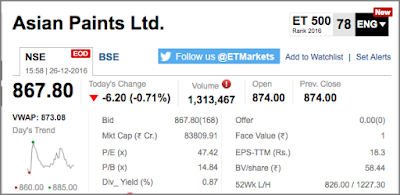Dear Friend!
I had recently prepared and posted a brief
investment research report of Asian Paints on this blog.
I find that indeed Asian Paints is very good
company. However the market has made it undue preference and made it very, very
expensive to invest in.
Have a look at the market snapshot of Asian
Paints share:
 |
| Asian Paints' Share's Market Snapshot |
A PE multiple of 47.42 and a P2BV of 14.84?
How can one justify such high valuations, that too for a company that is
displaying decent but ordinary profitability margins?
The final conclusions and my investment advice
are as follows:
Final Conclusions:
- Asian Paints is without doubt a great company with market leadership and strong brand value. It will shine in any value investor’s portfolio.
- The EBDITA, EBT and PAT margins are decent but nothing to brag about. The company is consistently profitable for many years into the past.
- Current Ratio is a bit weak but TOL/ TNW and Long-term Debt-Equity Ratio are strong.
- Free cash flows are good and well deployed.
- PE Ratio of 47.42 makes the share highly expensive.
- Price to Book Value Ratio (P2BV) of 14.84 again makes the share very expensive and unaffordable.
- The market condition parameters of five-year price graph and five year returns do not favour buying the share presently.
- Though the company is distributing a good proportion of the profits as dividends, the high market price has pulled down the dividend yield.
Final Investment Advice:
- Asian Paints is a good company.
- Market price is too high.
- Only during post Lehman Brothers bank collapse like situations will the price come down. Even then it will never come down enough to bring down below a PE of 15 and P2BV of below 1.5. Buy the Shares of Asian Paints only during such times. Certainly not now.
Please read the full
investment research report:
- Read at: Asian Paints Investment Research Report
- Download a free pdf version at: Download Asian Paints Investment Research Report
Happy Investing!
Thank you,
With Best Regards
Anand





